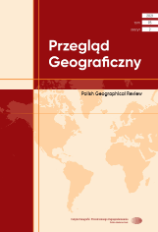Tytuł pozycji:
Czy regres publicznego transportu zbiorowego na obszarach górskich prowadzi do rozwoju niezrównoważonego? Przykład z Beskidu Niskiego i Bieszczad = Does regression in public transport in naturally-valuable areas lead to unsustainable development? A case study involving Poland’s Low Beskids and Bieszczady Mountains
24 cm
Ostatnie ponad 200 lat to okres gwałtownego rozwoju społeczeństw, w tym również i wzrostu ich dobrobytu. Zaowocowało to między innymi rosnącą ilością wolnego czasu, który zwłaszcza bardziej zasobne finansowo jednostki starały się wykorzystać na zaspokojenie potrzeb wyższego rzędu. Skutkiem tego jest przede wszystkim zwiększona mobilność związana z rekreacją i wypoczynkiem. Niestety typowym dla współczesnej cywilizacji jest to, że prawie wszystkie dziedziny gospodarki, w tym transport i turystyka, oddziałują niekorzystnie na środowisko naturalne. Masowy rozwój turystyki i jej negatywny wpływ na otoczenie sprawiają, że rosnące znaczenie mają zasady zrównoważonego rozwoju. Procesom tym powinno towarzyszyć pytanie o granice wzrostu ruchu turystycznego. Ponieważ transport jest integralną częścią sektora turystycznego, brak dogodnych możliwości przemieszczania się owocuje zmniejszaniem się potencjału turystycznego danego obszaru. Transport publiczny jest więc niezbędny na obszarach cennych przyrodniczo jako czynnik sprzyjający zmniejszaniu antropopresji, a zwłaszcza ograniczaniu destruktywnego wpływu motoryzacji indywidualnej. Bazując na powyższych przesłankach Autorzy podjęli się badań, których celem jest odpowiedź na pytanie: czy regres transportu publicznego na obszarach o dużej wartości środowiska naturalnego, takich Beskid Niski i Bieszczady, prowadzi do niezrównoważonego rozwoju? Latem 2019 r. Autorzy przeprowadzili badanie ankietowe pośród turystów odwiedzających obydwa te pasma górskie i przeanalizowali zmiany sieci transportu publicznego, jakie miały tam miejsce w latach 1990‑2019. Na badanym obszarze stale rosnący ruch turystyczny w połączeniu z brakiem wsparcia ze strony organizatorów transportu publicznego prowadzi do pogłębiania się niezrównoważonego rozwoju, a niewystarczająca oferta „przewoźników rozkładowych” nie pozostawia turystom alternatywy dla własnego samochodu i prowadzi do motoryzacji wymuszonej.
Transport is an integral part of tourism and the latter would not function without the development of the former. The issue of transport accessibility is of particular importance, when it comes to both reaching an area and the possibilities for moving around within it. A lack of convenient transport possibilities diminishes the tourist potential of a given area. Public transport is essential in naturally-valuable areas. Because of the massive development of tourism and its negative effects on the environment, sustainable development principles assume importance and questions arise regarding the limits of tourism’s development. The aim of this paper was to answer a specific question of relevance to the above, i.e. does the regression of public transport in the naturally-valuable areas that are Poland’s Low Beskid (Beskid Niski) and Bieszczady Mountains lead to unsustainable development? The authors carried out a questionnaire survey and analysed changes in the public-transport network between 2019 and 1990. Questionnaires were addressed to tourists visiting these mountains and included questions on accessibility to these mountain regions in the first place, as well as the possibilities for moving around within them. A database of public-transport timetables (valid as of the beginning of 2019) was created to analyse connections on an average working day, as well as during the weekends or holidays that are of special importance from the point of view of tourists. The survey results suggest that we may be dealing with the phenomenon of forced motorisation in tourism. In the case of the Low Beskids, and especially the Bieszczady Mountains, we can talk about a certain impoverishment of the offer regarding transport, with this ensuring – even during the holiday season – that tourists are forced to use private cars both on their way into the mountains and while travelling around within them. The interest tourists show in the Low Beskids, and especially the Bieszczady Mountains, has increased very markedly over the last 30 years. Unfortunately, the development of the offer as regards public transport has not merely failed to match that, but has followed an opposing trend. Scheduled bus and minibus services have stopped reaching many mountain villages. While these still reached many destinations as of 2019, they did so less often, or were confined to school days, hence implying a basic unsuitability for use in tourism. The role of rail transport in the studied area is marginal. Overall, the results obtained mediate against any possibility of truly sustainable development of transport in the area under study. Nevertheless, with a view to such a model for sustainable transport in the area studied being provided, the authors have sought to make certain recommendations. A favourable situation as regards this tourist region’s accessibility by public transport from places of residence is of course a precondition for any decision-making choice when it comes to selecting modes of travel that potential or actual tourists are in a position to make. Furthermore, direct connections will be important conditioners of desirable decisions, as will be timetables better tailored to the particular needs of tourists. As regards the making of transfers, greater frequency of connections and shorter travel times are further favourable aspects. On the other hand, it is important that the impact of individual motorisation around tourist destinations (or whole regions) should be limited, with this achievable where overall priority is assigned to scheduled public transport (as inevitably enjoying partial support from regional authorities).
